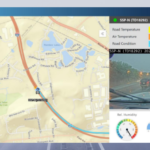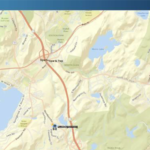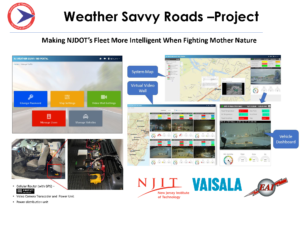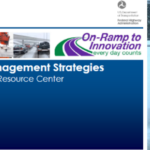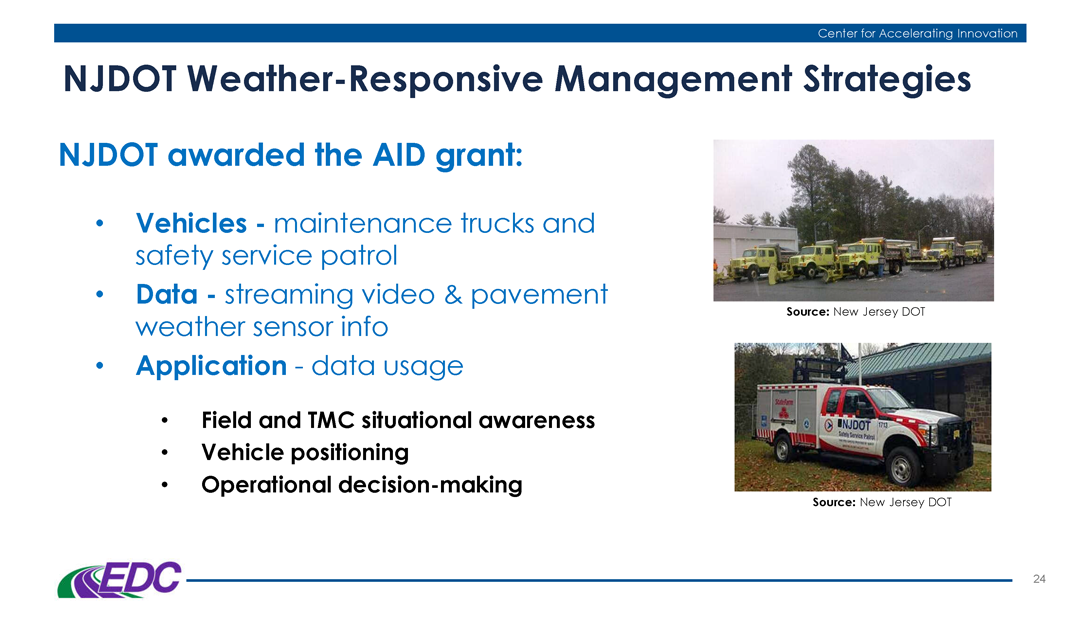NJDOT’s Transportation Mobility unit is working on several initiatives related to FHWA Every Day Counts innovative initiatives, including: Crowdsourcing for Advancing Operations (EDC-4, EDC-6), Next Generation Traffic Incident Management (EDC-4, EDC-6), and Weather Responsive Management Strategies (EDC-4, EDC-5). The unit has been creatively deploying STIC Incentive Grants and Accelerated Innovation Deployment (AID) grants to pilot test and evaluate innovations in recent years. We spoke with Sue Catlett, Project Manager in the Mobility Research Group, to provide updates on this work and discuss the coordination needed between agencies, organizations, and industry to make progress on these initiatives, and the barriers to deployment.

The Waycare crowdsourcing platform will feed information to NJDOT’s traffic operations centers to help resolve traffic issues and improve safety.
Crowdsourcing for Advancing Operations
Q. Can you give us an update on the STIC incentive grant and the pilot of the Waycare crowdsourced data platform?
Waycare is in the DOT’s procurement process. Once we have access to the information, the pilot will begin. We hope to see an increased situational awareness of the roadways.
Q. Once it is deployed, will you have data coming in immediately?
We anticipate that we will have data but we will need to evaluate what that data means to us. For example, a key consideration is the definition of terms such as “crash incident,” and “accident.” We need to determine if we accept what the system’s definition of a term is or if we can set a definition.
Once the Waycare system is operating, NJDOT’s Intelligent Transportation Systems Resource Center (ITSRC), housed at New Jersey Institute of Technology (NJIT), will be working with NJDOT on the evaluation of the information coming in and matching it up with other information that DOT is utilizing.
Next Generation Traffic Incident Management
Q. Can you update us on the deployment of the Computer Aided Dispatch (CAD) integration with the State Police? At the 3rd Quarter STIC meeting in September 2021, you mentioned that the State Police had deployed their CAD system and are still doing some fine-tuning.
The State Police deployed their system at the end of June and are continuing to make adjustments to the system and train staff in its use. They will be building out the system by adding modules. We are working with the State Police to determine how we will have access to the information gathered and we are working towards an agreement.
Q. Traffic Incident Management must require coordination with numerous organizations, yes?
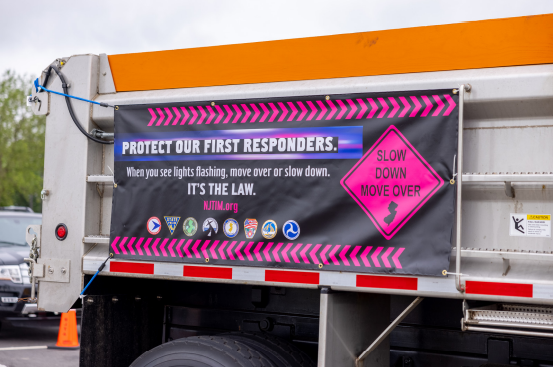
The Department promotes the safety of traffic incident first responders through their Move Over campaign.
Yes, in fact, we just had our statewide Traffic Incident Management (TIM) meeting today where we reported out on what we have been working on, what we will be doing in the next six months, and what help we will need from others. The various participating groups also report out. TIM involves coordination with first aid, EMS, the State Police, the MPOs, municipal fire departments, the Department of Health, and many others. We have been working on the Move Over bumper sticker campaign, and the National Crash Responder Safety Week was in November, so there are a lot of initiatives that we are working on through the year with a purpose of reducing time an incident is on a roadway and keeping first responders safe while responding to an incident.
Q. Has there been any progress on establishing an Advanced Traffic Management System (ATMS) platform or core software? What are the steps involved? What are you ultimately looking for with this platform?
In our operations centers, we gather data from many systems such as highway cameras, and travel times, as well as other information. The ATMS platform would combine these multiple platforms into one so that NJDOT operators can look in one place for all the information collected. The State Police CAD data could be included in this core software system.
We want one platform for our existing systems and we are also looking towards what we will need in the future. We worked with an engineering consultant firm to determine required elements, desired elements, and future needs. We were looking for a vendor that has a system that was already built and could then be customized to meet the Department’s needs. Any system would need to work with systems that DOT is currently using. We consulted with NJDOT Safety Service Patrol (SSP) and electrical maintenance, among others, to see what future needs they could anticipate. We wanted to cast a wide enough net to avoid missing something that other groups can anticipate now that they would need later on. We also talked to other state DOTs to receive feedback about their systems. The pandemic slowed progress on this effort and we have not contracted with a vendor yet.
It is anticipated that the platform will be built out through the addition of modular components. This makes it difficult to predict when the platform will be ready to use.
Weather Responsive Management Systems (WRMS)
Q. Congratulations on receiving the ITS-NJ 2021 Outstanding Project Award for the Weather Savvy Roads project. What is happening with the project?
The Weather Savvy Roads project was a collaboration with many individuals and organizations. The project has expanded to 23, and soon to be 24, equipped vehicles. Equipped trucks include six Safety Service Patrol vehicles (3 north, 3 south) which operate 24/7, two incident management response (IMRT) trucks which can respond to incidents at any time (1 north, 1 south), and Operations vehicles including 7 snow plow vehicles (3 north, 2 central, 2 south) and pickup trucks used by supervisors who can respond where needed. We are still working on modifications and analysis of the data we have received.
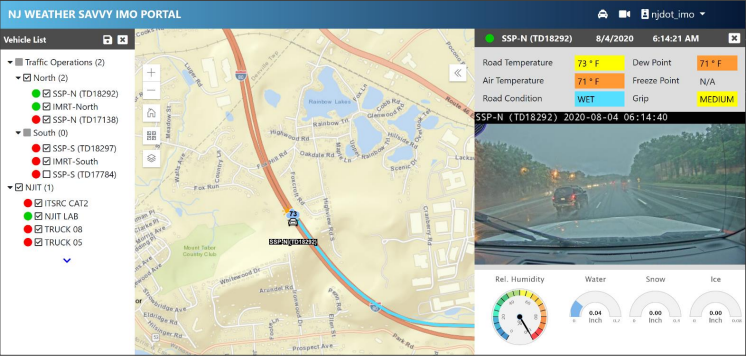
Weather Savvy instrumentation displays atmospheric conditions and a dashboard view of road conditions in real time.
The Mobile Road Weather Information System (MRWIS) provides information on ambient temperature, road temperature, road condition and grip, as well as a windshield view of road conditions. Management can see what the drivers are seeing. The information helps to assess a storm’s duration and intensity while it is ongoing. The data available through the system has helped management make decisions. For example, last winter a Director referred to the system to determine how much longer crews would need to be out on the road based on conditions, and could predict another two hours commitment.
WRMS can also assist in traffic incident management. Video of an incident, captured by an NJDOT responder truck, provides much more information than a verbal description of an incident scene. The detail can help ensure that individuals in the field can get the appropriate support and get the road back open more quickly.
NJDOT has extended the pilot deadline to June 2022 to include a second winter using the WRMS. This expansion will allow us to test the system on a potentially wider range of weather conditions, and assess the durability of the equipment. Last winter, NJIT analyzed the information we were collecting and found an issue with the data being reported. The vendor had to change their manufacturing process to address condensation issues and we installed replacement sensors.
Q. What do you anticipate being the next steps?
We are exploring how to bring this system inside the Department. Currently, the Weather Savvy website is hosted by the ITSRC at NJIT.
Other Innovative Initiatives Underway through Research or Other Activities
Q. Are there non-EDC innovations being undertaken at NJDOT or elsewhere in NJ that should be highlighted to STIC partners?
Drivewyze® is a phone app that is used to inform truck drivers of upcoming weigh stations, enabling drive-by of weigh stations, and provides in-cab alerts about slowdowns or other road issues. The Department could use the system to alert truckers to specific conditions, such as truck restrictions on snow-covered roadways before they enter the State, to allow truckers to make adjustments. NJDOT is trying the system out for a year to look at the value of the information and what impact it may have.
We are also using video analytics to look at truck parking in the Harding Truck Rest Area during winter storms. Both commercial trucks and Safety Service Patrol vehicles use this rest area, and the space can become overly full and entrances and exits can be blocked. SSP vehicles need to be able to get into and out of the area to respond to incidents and for shift changes. We installed devices in the parking stalls, which provide information indicating when they are occupied, and cameras identify when trucks are parked in non-marked parking spaces. From the data collected, we hope to determine prime times for usage, and we are trying to find a way to communicate with truckers. NJIT is conducting this study through the ITSRC.
Resources
More Information on the STIC initiatives highlighted in this interview is available using the following links:
Crowdsourcing for Advancing Operations - https://www.njdottechtransfer.net/2021/01/01/crowdsourcing-for-advancing-operations/
Next Generation TIM - https://www.njdottechtransfer.net/2021/04/19/next-generation-tim/
Weather Responsive Management Strategies - https://www.njdottechtransfer.net/weather-responsive-management-strategies/

